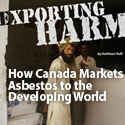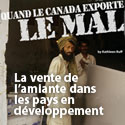Kathleen Ruff, RightOnCanada
The Russian government and the Russian asbestos industry claim that asbestos is mined under “safe, controlled conditions” in Russia and that it no longer poses any threat to the health of workers or nearby residents. According to the Russian government and scientists working for Russian government scientific institutes, the industry has, for many year, succeeded in ensuring that dust levels are strictly controlled.
The facts show a different situation, however. A report in the New York Times, City in Russia Unable to Kick Asbestos Habit, describes the following situation at the town of Asbest – location of the Uralasbest mine, the world’s biggest asbestos mine:
Asbestos is everywhere. Residents describe layers of it collecting on living room floors. Before they take in the laundry from backyard lines, they first shake out the asbestos. “When I work in the garden, I notice asbestos dust on my raspberries,” said Tamara A. Biserova, a retiree. So much dust blows against her windows, she said, that “before I leave in the morning, I have to sweep it out.”
“Every normal person is trying to get out of here,” Boris Balobanov, a former factory employee, now a taxi driver, explained. “People who value their lives leave. But I was born here and have no place else to go.”
Of the half-dozen people interviewed who worked at the factory or mine, all had a persistent cough, a symptom of exposure to what residents call “the white needles.” Residents also describe strange skin ailments. Doctors interviewed at a dermatology ward say the welts arise from inflammation caused by asbestos.
As was the situation at the town of Asbestos, Quebec, Asbest is a single industry town, thus making the residents hostage to a ruthless, deadly industry.
According to Dr. Evgeny Kovalevskiy, lead scientist at the Research Institute of Occupational Health of the Russian Academy of Medical Sciences, rigorous, safe working conditions have been instituted at the Uralasbest mine for many years and the mine no longer presents any health problems.
Kovalevskiy helps promote the asbestos trade. In May this year, as part of the Russian government delegation, he helped defeat the listing of chrysotile asbestos as a hazardous substance at the UN Rotterdam Convention conference. Court documents show that in 2012 he testified at the Supreme Court of Brazil on behalf of the Brazilian Chrysotile Institute (an industry lobby group) and a Brazilian trade union. Kovalevskiy argued that use of chrysotile asbestos should continue and that a proposed ban on asbestos in Brazil should be rejected. In testifying to the court, Kovalevskiy referred to Russia’s success in implementing strict controls over asbestos dust as evidence in support of continued use of chrysotile asbestos.
Scientists around the world have criticized the International Agency for Research on Cancer (IARC) for appointing Kovalevskiy and the Research Institute of Occupational Health of the Russian Academy of Medical Sciences as IARC collaborators on a Uralasbest study, since both have shown lack of integrity and both have a conflict of interest because of their promotion of uncontrolled trade in chrysotile asbestos and because of their misrepresentation of scientific research.



Sat, Jul 13, 2013
Asbestos